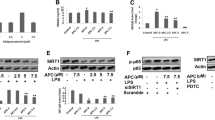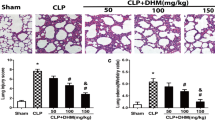Abstract
Acacetin, a flavonoid derived compound has been recognized for its diverse biological activities, such as anti-oxidative and anti-inflammatory effects. Acute lung injury (ALI) is a severe condition characterized by respiratory insufficiency and tissue damage, commonly triggered by pneumonia and severe sepsis. These conditions induce an inflammatory response via Toll-like receptor 4 (TLR4) signaling activation. This study explored acacetin's therapeutic potential against lipopolysaccharide (LPS) induced ALI in mice, focusing on its ability to modulate the NF-κB pathway via regulation of the Nod-like receptor family CARD domain containing 3 (NLRC3), a signal sensor that plays an important role in the regulation of inflammation and the maintenance of homeostasis. Our findings revealed that high-dose acacetin reduced the mortality rate of ALI mice, significantly ameliorated LPS-induced lung pathological changes, reduced lung edema, and decreased the expression of inflammatory mediators in lung tissues. This protective impact of acacetin appears to stem form its capacity to enhance NLRC3 expression, which, intern, can inhibit the activation of NF-κB and subsequently inhibit the production of inflammatory mediators. NLRC3 deficiency inhibits the protective effect of acacetin on ALI mice. Molecular docking also verified that acacetin tightly bound acacetin to NLRC3. Additionally, acacetin was found to influence macrophage recruitment dynamics via NLRC3, inhibiting the overactivation of NLRC3-NF-κB related pathways. Taken together, our results indicate that acacetin inhibited LPS-induced acute lung injury and macrophage overrecruitment to the lungs in mice by upregulating NLRC3.









Similar content being viewed by others
Data Availability
No datasets were generated or analysed during the current study.
References
Hughes, K.T., and M.B. Beasley. 2017. Pulmonary Manifestations of Acute Lung Injury: More Than Just Diffuse Alveolar Damage. Archives of Pathology and Laboratory Medicine 141 (7): 916–922.
Kumar, V. 2020. Pulmonary Innate Immune Response Determines the Outcome of Inflammation During Pneumonia and Sepsis-Associated Acute Lung Injury. Frontiers in Immunology 11: 1722.
Long, M.E., R.K. Mallampalli, and J.C. Horowitz. 2022. Pathogenesis of pneumonia and acute lung injury. Clinical Science (London, England) 136 (10): 747–769.
Tang, J., L. Xu, Y. Zeng, et al. 2021. Effect of gut microbiota on LPS-induced acute lung injury by regulating the TLR4/NF-kB signaling pathway. International Immunopharmacology 91: 107272.
Yuan-Yuan, Z., Z. Bo-Hua, S. Wei-Guo, et al. 2014. Research progress on biological activity of Robinia pseudoacacia (in Chinese) [j]. Chinese Journal of New Drugs 23 (09): 1053–1056+1080
Cho, H.I., J.H. Park, H.S. Choi, et al. 2014. Protective mechanisms of acacetin against D-galactosamine and lipopolysaccharide-induced fulminant hepatic failure in mice. Journal of Natural Products 77 (11): 2497–2503.
Chang, B., Z. Wang, H. Cheng, et al. 2024. Acacetin protects against sepsis-induced acute lung injury by facilitating M2 macrophage polarization via TRAF6/NF-κB/COX2 axis. Innate Immunity 30 (1): 11–20.
Wu, D., Y. Wand, H. Zhang, et al. 2018. Acacetin attenuates mice endotoxin-induced acute lung injury via augmentation of heme oxygenase-1 activity. Inflammopharmacology 26 (2): 635–643.
Sun, L.C., H.B. Zhang, C.D. Gu, et al. 2018. Protective effect of acacetin on sepsis-induced acute lung injury via its anti-inflammatory and antioxidative activity. Archives of Pharmacal Research 41 (12): 1199–1210.
Velloso, F.J., M. Trombetta-Lima, V. Anschau, et al. 2019. NOD-like receptors: major players (and targets) in the interface between innate immunity and cancer. Bioscience Reports 39 (4):BSR20181709. https://doi.org/10.1042/BSR20181709. PMID: 30837326; PMCID: PMC6454022.
Ye, Z., and J.P. Ting. 2008. NLR, the nucleotide-binding domain leucine-rich repeat containing gene family. Current Opinion in Immunology 20 (1): 3–9.
Zhao, Y., and R. Li. 2023. Overview of the anti-inflammatory function of the innate immune sensor NLRC3. Molecular Immunology 153: 36–41.
Li, Z.T., H. Liu, and W.Q. Zhang. 2020. NLRC3 alleviates hypoxia/reoxygenation induced inflammation in RAW264.7 cells by inhibiting K63-linked ubiquitination of TRAF6. Hepatobiliary & Pancreat Diseases International 19 (5): 455–460.
Schneider, M., A.G. Zimmermann, R.A. Roberts, et al. 2012. The innate immune sensor NLRC3 attenuates Toll-like receptor signaling via modification of the signaling adaptor TRAF6 and transcription factor NF-κB. Nature Immunology 13 (9): 823–831.
Fu, Y., X. Zhan, Y. Wang, et al. 2019. NLRC3 expression in dendritic cells attenuates CD4(+) T cell response and autoimmunity. EMBO Journal 38 (16): e101397.
Hu, S., X. Du, Y. Huang, et al. 2018. NLRC3 negatively regulates CD4+ T cells and impacts protective immunity during Mycobacterium tuberculosis infection. PLoS Pathogens 14 (8): e1007266.
Karki, R., R.K.S. Malireddi, Q. Zhu, et al. 2017. NLRC3 regulates cellular proliferation and apoptosis to attenuate the development of colorectal cancer. Cell Cycle 16 (13): 1243–1251.
Krishnan, R., R. Rajendran, Y.S. Jang, et al. 2022. NLRC3 attenuates antiviral immunity and activates inflammasome responses in primary grouper brain cells following nervous necrosis virus infection. Fish & Shellfish Immunology 127: 219–227.
Zha, L.H., J. Zhou, Y. Tan, et al. 2020. NLRC3 inhibits PDGF-induced PASMCs proliferation via PI3K-mTOR pathway. Journal of Cellular Physiology 235 (12): 9557–9567.
Li, R., Y. Zhao, X. Zhang, et al. 2023. NLRC3 Participates in Inhibiting the Pulmonary Inflammatory Response of Sepsis-Induced Acute Lung Injury. Immunological Investigations 52 (5): 567–582.
Zhou, Z.H., B. Sun, K. Lin, et al. 2000. Prevention of rabbit acute lung injury by surfactant, inhaled nitric oxide, and pressure support ventilation. American Journal of Respiratory and Critical Care Medicine 161 (2 Pt 1): 581–588.
Assouvie, A., L.P. Daley-Bauer, and G. Rousselet. 2018. Growing Murine Bone Marrow-Derived Macrophages. Methods in Molecular Biology 1784: 29–33.
Ye, H., Y. Zhou, P. Ma, et al. 2020. Analysis of the anti-inflammatory effect of the aptamer LA27 and its binding mechanism. International Journal of Biological Macromolecules 165 (Pt A): 308–313.
Murray, J.F. 2011. Pulmonary edema: pathophysiology and diagnosis. International Journal of Tuberculosis Lung Disease 15 (2): 155–160.
Berghe, T.V., D. Demon, P. Bogaert, et al. 2014. Simultaneous targeting of IL-1 and IL-18 is required for protection against inflammatory and septic shock. American Journal of Respiratory and Critical Care Medicine 189 (3): 282–291.
Millar, M.W., F. Fazal, and A. Rahman. 2022. Therapeutic Targeting of NF-κB in Acute Lung Injury: A Double-Edged Sword. Cells 11 (20): 1.
Singh, S., P. Gupta, A. Meena, et al. 2020. Acacetin, a flavone with diverse therapeutic potential in cancer, inflammation, infections and other metabolic disorders. Food and Chemical Toxicology 145: 111708.
Wu, C., J. Yan, and W. Li. 2022. Acacetin as a Potential Protective Compound against Cardiovascular Diseases. Evid Based Complement Alternat Med 2022: 6265198.
Li, S., Q. Lv, X. Sun, et al. 2020. Acacetin inhibits Streptococcus pneumoniae virulence by targeting pneumolysin. Journal of Pharmacy and Pharmacology 72 (8): 1092–1100.
Li, S., X. Xu, L. Wei, et al. 2022. Acacetin Alleviates Listeria monocytogenes Virulence Both In Vitro and In Vivo via the Inhibition of Listeriolysin O. Foodborne Pathogens and Disease 19 (2): 115–125.
Xie, S., Y. Zhang, L. Xu, et al. 2022. Acacetin attenuates Streptococcus suis virulence by simultaneously targeting suilysin and inflammation. Microbial Pathogenesis 162: 105354.
Foster, D.M., and J.A. Kellum. 2023. Endotoxic Septic Shock: Diagnosis and Treatment. International Journal Molecular Sciences 24 (22):16185. https://doi.org/10.3390/ijms242216185. PMID: 38003374; PMCID: PMC10671446.
Chen, H., C. Bai, and X. Wang. 2010. The value of the lipopolysaccharide-induced acute lung injury model in respiratory medicine. Expert Review of Respiratory Medicine 4 (6): 773–783.
Bhatia, M., and S. Moochhala. 2004. Role of inflammatory mediators in the pathophysiology of acute respiratory distress syndrome. The Journal of Pathology 202 (2): 145–156.
Allen, I.C. 2014. Non-Inflammasome Forming NLRs in Inflammation and Tumorigenesis. Frontiers in Immunology 5: 169.
Sun, D., J. Xu, W. Zhang, et al. 2022. Negative regulator NLRC3: Its potential role and regulatory mechanism in immune response and immune-related diseases. Frontiers in Immunology 13: 1012459.
Uchimura, T., Y. Oyama, M. Deng, et al. 2018. The Innate Immune Sensor NLRC3 Acts as a Rheostat that Fine-Tunes T Cell Responses in Infection and Autoimmunity. Immunity 49 (6): 1049–1061.
Zhou, J.T., K.D. Ren, J. Hou, et al. 2021. α-rhamnrtin-3-α-rhamnoside exerts anti-inflammatory effects on lipopolysaccharide-stimulated RAW264.7 cells by abrogating NF-κB and activating the Nrf2 signaling pathway. Molecular Medicine Reports 24 (5):):799. https://doi.org/10.3892/mmr.2021.12439. Epub 2021 Sep 15. PMID: 34523697; PMCID: PMC8456313.
Xu, J., C. Gao, Y. He, et al. 2023. NLRC3 expression in macrophage impairs glycolysis and host immune defense by modulating the NF-κB-NFAT5 complex during septic immunosuppression. Molecular Therapy 31 (1): 154–173.
Funding
This study was supported by the National Natural Science Foundation of China (Nos. 81770056, 81971563, 82272330) and Key Research and Development Project of Shaanxi province (2023-YBSF-405).
Author information
Authors and Affiliations
Contributions
Y.C.X and B.Z wrote the main manuscript text, S.Y.H, X.S and R.R.L prepared Figs. 1–9. ALL authors reviewed the manuscript.
Corresponding authors
Ethics declarations
Ethics Statement
The experimental procedures was approved by the Institutional Animal Ethics and Use Committee of the Fourth Military Medical University.
Conflict of Interests
The authors declare no competing interests.
Additional information
Publisher's Note
Springer Nature remains neutral with regard to jurisdictional claims in published maps and institutional affiliations.
Rights and permissions
Springer Nature or its licensor (e.g. a society or other partner) holds exclusive rights to this article under a publishing agreement with the author(s) or other rightsholder(s); author self-archiving of the accepted manuscript version of this article is solely governed by the terms of such publishing agreement and applicable law.
About this article
Cite this article
Xiao, Y., Zhang, B., Hou, S. et al. Acacetin Attenuates Sepsis-induced Acute Lung Injury via NLRC3-NF-κB Pathway. Inflammation (2024). https://doi.org/10.1007/s10753-024-02040-3
Received:
Revised:
Accepted:
Published:
DOI: https://doi.org/10.1007/s10753-024-02040-3




